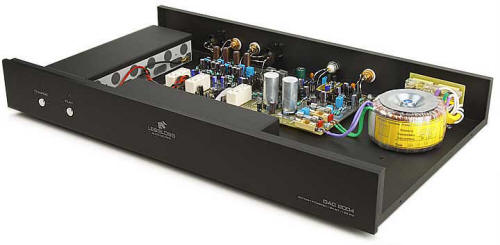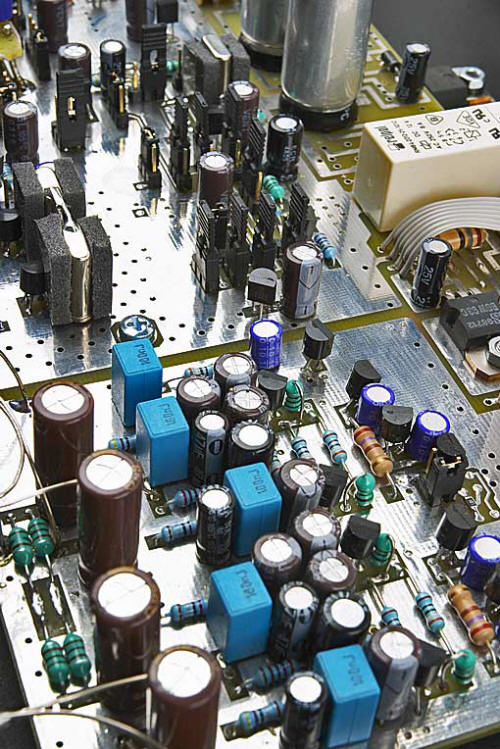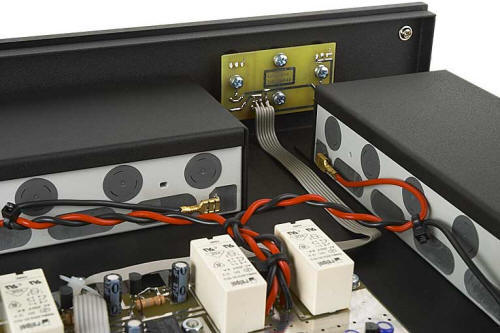
You are reading the older HTML site
Positive Feedback ISSUE
january/february 2008
lessloss
DAC 2004
as reviewed by Danny Kaey

All images courtesy of the manufacturer
|
DANNY KAEY'S SYSTEM
LOUDSPEAKERS
ELECTRONICS
SOURCES Digital: LessLoss DAC2004, CEC TL51X tranpsort, Slimdevices Squeezebox 3, Slimdevices Transporter w/ Modwright Truth mod, ZeroOne Ti48/Ar38, 2007 MacBook.
CABLES
ACCESSORIES
|
The other day a friend, whom I hadn't seen in ten years, came over for a visit and bewildered at the equipment he saw, pronounced me "nuts". What with tape machines, tube amps (vintage and new), solid-state amps, vinyl records, cables, carbon fiber racks, etc, he said, "Danny, since college I always new you had a knack for esoteric stuff." "Esoteric? Wait a minute Hrundi (the names have been changed to protect the innocent), not much odd-ball stuff here actually, most of the technology is half a century old or more and hey, I play mp3's too you know." As he gazed over the equipment, he paused for a minute "Hrmm… what's this thing do?" "That? Oh. Oh that! Ah, that my dear friend, that is this new DAC from a small time Lithuanian company, called the LessLoss, the DAC 2004." "Lithuania? DAC? Ok, now you really are an oddball Danny!"
Oddball or not, I simply couldn't help but notice a company such as LessLoss. Settled in Lithuania, this little pro-west, ex-Communist Russian satellite, it appears to be prospering in its own right. In fact, Lithuania has such a rich and truly interesting history you owe it to yourself to check out the fact sheet on Wikipedia.
The two faces of LessLoss are the company's emblem, a dashingly handsome Elk, and Liudas Motekaitis, a text book hands-on small business owner. A third person, the reclusive scientist behind the DAC, Vilmantas Duda, is essentially one of those highly educated Eastern European geniuses who feels his time is best spent furthering the development of all things digital.
I first heard of LessLoss a year or so ago when I was doing some research for high quality outboard DACs. Struck by the brilliance of perhaps the most well thought-out and inspiring websites in the biz (www.LessLoss.com), I was immediately impressed. Of course, designing a nice looking website is child's play these days: the question was, "is this real or is it Memorex?" Near instant email replies, outstanding command of the English language and a genuine interest in my sonic preferences prompted me to ponder what was going on. The Internet has become the depository for quick buck scams, fly by night operations and other such nasties. Surely, this could not be one of those companies.
The truth is far more simple then one would expect: Liudas is American by birth, he grew up in Texas before he moved to Lithuania via New York, Germany and brief stints in Austria. "Ahh …that explains it!"

The LessLoss DAC 2004 design
The DAC is interesting from several perspectives; the attention to detail becomes immediately apparent when you read the DACs spec sheet. Liudas and "Vil" are big on two key aspects of digital design: jitter (or lack thereof), clean power and solid grounding. The DAC 2004 uses parallel Burr-Brown 1704 (the most expensive kind, no longer made) multi-bit converters, a hybrid dual-battery power supply (interestingly, the battery supply powers only the analog output section, whereas the digital section is powered by the mains line through an intricate and extensive filter network), optionally available distortionless volume control, all hand assembled and tested with a nicely worked and custom laser engraved chassis. All in all, the DAC 2004 looks rather unassuming and plain Jane. It measures about two inches in height, it is one of those audio components that gets out of the way rather then calling attention to itself—hey, that's fine by me! At the back of the DAC 2004 are pairs of balanced and single-ended outputs, a digital SPDIF input, and a superclock output as well as a standard IEC socket.

As mentioned, Liudas and Vil feel that jitter is the true culprit for digital's bad sound and it is indeed refreshing to see these guys take somewhat of a different approach to DAC design then most companies. While the DAC 2004 can of course be used with any digital component, LessLoss has a long history of recommending in particular those CD players which feature a superclock input. Since this feature isn't your typical garden-variety add-on most manufacturers supply, Liudas and Vil went the route of modifying certain Rega CD players for the job. As if by pure chance, some months ago, an update was posted on their website informing prospective buyers of a newly discovered alternative: the belt driven CEC TL51X transport appeared nearly perfect for the job. Reverse engineering the superclock input to accommodate for the DAC 2004 signal, it was off to the races. None of the previously reviewed DACs that have come through my place over the last year appear anywhere remotely as elaborate and intricately designed as the DAC 2004.
Of Rockstars and LessLoss…
During the time of this review, Liudas happened to be touring the US, literally driving cross-country on several occasions to demonstrate his company's latest wares. The DAC 2004, various interconnects and power cords as well as a prototype out of this world power conditioner (trust me, you have never seen something quite like it!). As a result of this several month long trek across 48 states I was in possession of the complete LessLoss system i.e. DAC 2004, CEC TL51X and a full compliment of interconnects and power cords. Speaking of those cables: apparently LessLoss is making quite the name for themselves if ongoing accolades around the web are to be taken literally. In any event, the LessLoss system can be viewed upon as the defacto reference Liudas and Vil utilize to further develop the various technologies they are continuously working on.
Regardless of the clever technology behind the DAC 2004, it does face some serious competition out of the gate. First, sub $2k digital converters have been popularized by homemade music servers and there's a plethora of them available; second, CD transport add-on standalone DACs aren't quite as popular as they used to be say five or ten years ago in the mainstream marketplace. Most companies have abandoned the two-unit approach to compact disc playback and those that didn't typically offer matched transport and DAC designs in one form or another. On the other hand, cost no object audio jewelry type separates do in fact favor the split box design, alas, those components don't start below say $20k and are built to what must be Swiss watch standard specs fit and finish.
What if the DAC 2004 however, turned out to be a giant slayer? What if this DAC was able to single-handedly realign my perceptions of digital playback to levels I have not heard before in my setup? What if LessLoss was indeed on to something very special? What if I was puffing up nothing but hot smoke? What if…? As with all things audio, the truth will undoubtedly lie somewhere in between those goal posts, though come to think of it, I used to hold several 11 meter free kick records in my old boarding school.
Just another DAC? Hardly!
Right off the bat, the LessLoss DAC is one hell of a converter, if I dare say so. This Eastern European special agent has suddenly undone my previous references, the laughably good Lector 0.6t CD player or the remarkably analog sounding Lavry Engineering DA10. First, the LessLoss miracle DAC strikes you as being incredibly open, utterly transparent, quick and extended in both frequency extremes. It has a natural, smooth, neither harsh nor digital sound, one that reminds me most of the Lavry DA10 I had for six or so months. Dynamics, both micro and macro, are handled with aplomb through the LessLoss DAC; in fact, sometimes I had to remind myself that I was only listening to good ol' Redbook standard, so grand and limitless was the presentation.
A classic example of this is how the LessLoss handles dynamic recordings such as Dr. Keith Johnson's Reference Recording of "The Vikings" [RR, Pomps & Pipes]. Wind instruments open the track and shortly into the performance a thunderous and prodigious organ hits the low C pedal. Indeed, it's shake, rattle and role! When pants flap, your windows rattle, you know it's time to put on that 6-point racing harness, 'cause this is the big one. Unlike lesser digital, say the Lavry DA10 or Lector 0.6t in particular, the DAC 2004 also manages to unfold all the nuances that come along with these dynamic excursions. As the organ hits the lowest octave, you can still clearly make out the lower register percussion, which somehow tends to get washed out somewhat with other converters and players.
Meanwhile, vocals aren't short shifted either: take for example Audrey Morris's "Blah, Blah, Blah" [RCA, Bistro Ballads], which is one of my latest female vocalist discoveries, courtesy of Mr. Record. An early 50's full track mono recording, Audrey sings a seemingly simplistic tune, accompanied by a lone piano. The difference between the resolving power of the LessLoss DAC and the otherwise quite good ZeroOne Ti48/Ar 38 combo is nothing short of stunning. Here, Audrey's vocals appear clearly and separately, as though in a different plane, from the piano; yet, musically they appear as one whole. Sounds like an oxymoron, though I assure you, the same track sounds far less resolved and defined through any of my other digital gear.
Those Eastern Europeans…
Mind you, the $2100 Lector player, through its tube output stage, did manage at times to sound more marvelous and sweet when playing back vocals, say the aforementioned Audrey Morris, Dean Martin, or ol' blue eyes Frank. Alas, having the LessLoss system on hand, I concluded that the sweetness and delight you were rewarded with was a tradeoff in sum. While I may prefer the added warmth the tube output stage added to the mix, I believe the LessLoss reading of the material to be the more precise and correct one ultimately. Different strokes for different folks; some prefer white, others red. Which Coke tastes more correct? Coke Classic or Coke Zero?
East meets West
Yello's "Planet Dada Flamboyant Mix" [Universal, The Eye], is my quintessential demo track to judge oh, a good half dozen or so system checkpoints. What can I say, I am beholden to classy synth-pop music, in particular that of the Swiss duo's persuasion. The massive pro-tools derived dynamic thwacks, bass lines, and whizzbang effects of this track are always in prime. Typically, these layers upon layers of musical auras, while projected with proper authority, slam and definition, at times can sound slow and lacking in correct timing. While you wouldn't necessarily notice this behavior up front, it does become rather evident and clear in direct comparison to the LessLoss DAC. What is at once fundamentally the same track suddenly takes on a whole new level of engagement, pace and time alignment.
I could easily say that this is the best DAC on the planet—while I think it is indeed very good, you owe it to yourself to listen to the incredible resolution and projection the LessLoss DAC manages to convert from good old Redbook. Mel Torme's Swinging By The Moonlight is just another example of that kind. A splendid digital transcription from the analog masters, this Verve disc sounds absolutely unreal in the strictest sense of the word. Track 5, "How High The Moon" offers jaw dropping depth, width, and image size, coupled with just the right amount of midrange bloom give the appearance of Mel truly singing in your room. The gritless, grain-free and utter transparency of the recording will leave you with but one question: is it possible for the master tapes to sound any better?
The Meat and Potatoes…
Precision is perhaps the correct term for everything the LessLoss does. There is simply more of it in general and specific terms than any other DAC I have had my hands on and there have been quite a few. Whatever the musical genre, the LessLoss DAC always came out on top: the delicacy and resolve of Audrey Morris and Mel Torme; the dynamic extension on tracks by Yello, K&D, or Dr. Keith Johnson's recordings; no matter, the LessLoss DAC 2004 handles these with exemplary quality and finesse. What is particularly striking about the LessLoss system is the fact that it does not sound harsh, lean, or edgy, attributes once could ascribe to such precise type gear. In short, the DAC 2004 does the almost unthinkable: when I wrote the review for the Lavry DA10 for another publication, I proclaimed it to be the most analog sounding DAC I have heard. The LessLoss system adds resolution, transparency and just the right amount of sweetness and delight to the mix, establishing it clearly as my new reference.
What happens when you take apart the LessLoss system? The short answer is that you will hear somewhat of a performance loss. Sure, quantifying "somewhat" leaves the door open to all sorts of interpretations. In general terms I would say that using the standard coax digital connection will yield roughly the same presentation. What you lose is a smidgen of texture here, a bit less dynamic control there. Increased signs of jitter perhaps. I do believe that the loss of performance in direct comparison is more than made up for by the overall superior execution of the LessLoss design. That is a testament to the ingenuity of Vil's engineering skills, no more, no less. One can always look at it this way: at $4410 (current Euro/Dollar conversion) you can easily have one of the best DACs out there. At $4400 plus the cost of the CEC transport (around $1300), you will have state of the art sound.
But wait, there's more!
Finally, a few more general comments I think are news worthy. First, battery life of the LessLoss DAC was nothing short of outstanding: in several months of nearly daily use, the battery has never run dry. Recall that the unit is plugged into your wall socket (or conditioner) 24-7, whilst an automatic trickle charger makes sure that batteries are always charged whenever necessary. For the end user, this is a totally transparent process; no interaction is required, making for a great usability experience. Clever, as you get the benefit of battery power, whilst never seeing the downside of recharging, etc.

Second, guaranteed future proof upgradeability: ten years ago, that phrase didn't carry nearly as much weight as it does today. The reasons are simple and rooted in the fact that back then, the only digital source available was your disc transport. Today however, the term "future proof" carries much more weight. Computer streaming devices, networked music players, and revolutionary new disc transports (PS Audio's Perfect Wave Transport, PWT immediately comes to mind) are all competing hand over fist for your consuming, almighty dollar. I have already tested the LessLoss DAC 2004 on my Squeezebox 3; Paul McGowan promised to ship one of the first PWT Transports for evaluation this summer. Exciting times are indeed ahead!
The Greats…
I tossed out the phrase Giant Slayer earlier—some believe this is simply not possible; they will claim that in the end, only companies which have the appropriate wherewithal are in fact capable of designing and implementing a reference level component. While there are certain elements of truth in that premise, I have to disagree at the fundamental level. It was none other than Nikola Tesla who brought us AC or Alternating Current the foundation for our modern day lives. It was none other than Sir Isaac Newton who defined the laws of universal gravitation. Last I checked those were all individual men sans corporate baggage and bean counters that revolutionized our way of life. Is the LessLoss DAC 2004 therefore a revolutionary, groundbreaking product? Certainly not within the context of the former gent's monumental accomplishments.
I do however believe that LessLoss has in fact created a reference quality product for far less than perceived reference price. Given that Lithuania has quickly established itself as leaders in the technology sector, in particular laser production (as it turns out, many of the leading worldwide companies and labs utilize laser assemblies from Lithuania), it comes as no surprise that Vil and Liudas have a winner on their hands. To those who wish giant killing performance at real-world prices, the LessLoss DAC 2004 is the pick. Most highly recommended! Danny Kaey
DAC 2004
Retail: $4400 US
LessLoss
website: www.LessLoss.com
